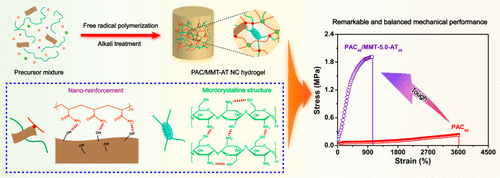当前位置:
X-MOL 学术
›
ACS Appl. Polym. Mater.
›
论文详情
Our official English website, www.x-mol.net, welcomes your feedback! (Note: you will need to create a separate account there.)
Mechanically Robust Polyacrylamide Composite Hydrogel Achieved by Integrating Lamellar Montmorillonite and Chitosan Microcrystalline Structure into Covalently Cross-linked Network
ACS Applied Polymer Materials ( IF 5 ) Pub Date : 2020-03-23 , DOI: 10.1021/acsapm.0c00106 Shi-Neng Li 1, 2 , Baoqiang Li 1, 2 , Zhi-Ran Yu 3 , Shou-Wei Dai 3 , Shi-Chang Shen 3 , Min Mao 3 , Li-Xiu Gong 3 , Yujie Feng 1 , Dechang Jia 1, 2 , Yu Zhou 1, 2 , Long-Cheng Tang 3, 4
ACS Applied Polymer Materials ( IF 5 ) Pub Date : 2020-03-23 , DOI: 10.1021/acsapm.0c00106 Shi-Neng Li 1, 2 , Baoqiang Li 1, 2 , Zhi-Ran Yu 3 , Shou-Wei Dai 3 , Shi-Chang Shen 3 , Min Mao 3 , Li-Xiu Gong 3 , Yujie Feng 1 , Dechang Jia 1, 2 , Yu Zhou 1, 2 , Long-Cheng Tang 3, 4
Affiliation

|
Hydrogels have been attracting much attention on account of their soft and wet nature but inherently poor and unbalanced mechanical performance severely limits their applications. Herein, we reported a strategy to fabricate polyacrylamide/chitosan/montmorillonite nanocomposite hydrogels by simultaneously introducing lamellar montmorillonite and chitosan microcrystalline structure via a facile and universal two-step method composed of in situ free radical polymerization and alkali treatment . The incorporation of two-dimensional nanoclay and chitosan microcrystalline structure into polyacrylamide network synergistically facilitated the formation of robust and uniform polymer architecture through physical interactions and thus significantly improved the mechanical behavior. As a result, the satisfactory mechanical properties of the optimal nanocomposite hydrogels were achieved at a relative high water content (80 wt %), including a superior tensile strength of 1.91 MPa, high tensile strain of 1005%, and exceptionally great toughness of 14.16 MJ·m–3, respectively. Furthermore, they also possessed excellent compressive properties assessed from cyclic tests. On the basis of the structural evolution observation and analysis, a possible strengthening mechanism for enhanced mechanical properties was discussed and proposed. This high-performance nanocomposite hydrogel shows great potential as a promising candidate for structural or load-bearing materials.
中文翻译:

通过将层状蒙脱石和壳聚糖微晶结构整合到共价交联网络中获得机械坚固的聚丙烯酰胺复合水凝胶
水凝胶由于其柔软和湿润的性质而备受关注,但其固有的不良和不平衡的机械性能严重限制了其应用。在这里,我们报告了一种策略,该方法通过通过原位组成的简便且通用的两步方法同时引入层状蒙脱土和壳聚糖微晶结构来制备聚丙烯酰胺/壳聚糖/蒙脱土纳米复合水凝胶自由基聚合和碱处理。将二维纳米粘土和壳聚糖微晶结构并入聚丙烯酰胺网络中,可通过物理相互作用协同促进形成稳固而均匀的聚合物结构,从而显着改善了机械性能。结果,在相对较高的水含量(80重量%)下获得了最佳纳米复合水凝胶的令人满意的机械性能,包括1.91 MPa的优异拉伸强度,1005%的高拉伸应变以及14.16 MJ的超强韧性·米–3, 分别。此外,它们还具有通过循环测试评估的优异压缩性能。在结构演变的观察和分析的基础上,讨论并提出了一种可能的增强力学性能的增强机理。这种高性能的纳米复合水凝胶显示出巨大的潜力,可作为结构或承重材料的有希望的候选者。
更新日期:2020-03-23
中文翻译:

通过将层状蒙脱石和壳聚糖微晶结构整合到共价交联网络中获得机械坚固的聚丙烯酰胺复合水凝胶
水凝胶由于其柔软和湿润的性质而备受关注,但其固有的不良和不平衡的机械性能严重限制了其应用。在这里,我们报告了一种策略,该方法通过通过原位组成的简便且通用的两步方法同时引入层状蒙脱土和壳聚糖微晶结构来制备聚丙烯酰胺/壳聚糖/蒙脱土纳米复合水凝胶自由基聚合和碱处理。将二维纳米粘土和壳聚糖微晶结构并入聚丙烯酰胺网络中,可通过物理相互作用协同促进形成稳固而均匀的聚合物结构,从而显着改善了机械性能。结果,在相对较高的水含量(80重量%)下获得了最佳纳米复合水凝胶的令人满意的机械性能,包括1.91 MPa的优异拉伸强度,1005%的高拉伸应变以及14.16 MJ的超强韧性·米–3, 分别。此外,它们还具有通过循环测试评估的优异压缩性能。在结构演变的观察和分析的基础上,讨论并提出了一种可能的增强力学性能的增强机理。这种高性能的纳米复合水凝胶显示出巨大的潜力,可作为结构或承重材料的有希望的候选者。



























 京公网安备 11010802027423号
京公网安备 11010802027423号